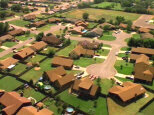Condo Associations and HOAs: Distinctions Create Many Differences
I want to talk about the ABCs of community associations, or, more precisely, the CAs and HOAs, which can be confusing even to people who live in one of these communities.First the basics: Condominium Associations and Home Owner Associations — CAs and HOAs, respectively — are the corporate entities governing different kinds of common interest ownership communities. HOAs aren’t as common in New England as in other parts of the country and they tend to be much smaller here than in states such as California and Florida, where they are the dominant form of common interest ownership.
 The two terms ─ HOAs and CAs ― are often used interchangeably, though incorrectly, because there are significant differences between them. HOAs almost always govern communities of detached single-family homes in which residents own their lots and the structures on them. Condominium associations typically govern communities of multi-family buildings or semi-attached town homes in which owners own their dwellings individually and share ownership of the common elements. In an HOA, it is the association itself, not the owners, that owns the common elements, through a deed conveyed by the developer. This one of the key differences between CAs and HOAs, and it produces other important distinctions.Maintenance Obligations. A condominium association is responsible for maintaining the common areas and sometimes limited common areas, which usually include building exteriors as well as amenities (pools, clubhouses, etc.) parking areas, roadways and the grounds. An HOA is similarly responsible for maintaining common elements, but there usually aren’t as many of them – certainly fewer than in most condo communities. (In the HOA is which I live, the only common element is a small flower island near the entryway.)Where the condo association would typically be responsible for maintaining the siding, roofs and decks in a condominium community, in an HOA, the owners are usually responsible for maintaining the exterior of their homes. In a condo association, owners would usually expect the association to take care of mowing the grass and trimming the hedges; in an HOA, the association would usually expect owners to take care of their own yards.Governance. Condo associations in New England are governed not only by their organizing documents but also by state condominium laws. And the condo statutes in the New England states don’t cover HOAs. This is another critical difference between these entities. An authority or obligation that isn’t provided in a condo association’s governing documents may be included in the state condo statute. If the HOA’s declaration doesn’t include an authority or an obligation, there is no specific law to support it.An example is the Massachusetts Superlien statute that allows condo associations to collect up to six months of delinquent assessments from owners, plus court costs and attorneys’ fees in advance of the first mortgage holder. Because the statute doesn’t cover HOAs, they don’t have the same authority to impose a lien on delinquent owners and to foreclose (if necessary) to enforce it, unless that authority is included in their declaration.Some HOA documents reference the Superlien statute, but most do not, leaving these associations without the powerful collection tool that the law provides to condo associations. Because HOA budgets and the fees they collect are typically much smaller than those of condo associations, delinquencies may not create the same financial risk for them. Still, the lack of statutory authority on which to rely leaves HOAs not only with less collection power but also with less overall enforcement firepower than condo associations can muster.
The two terms ─ HOAs and CAs ― are often used interchangeably, though incorrectly, because there are significant differences between them. HOAs almost always govern communities of detached single-family homes in which residents own their lots and the structures on them. Condominium associations typically govern communities of multi-family buildings or semi-attached town homes in which owners own their dwellings individually and share ownership of the common elements. In an HOA, it is the association itself, not the owners, that owns the common elements, through a deed conveyed by the developer. This one of the key differences between CAs and HOAs, and it produces other important distinctions.Maintenance Obligations. A condominium association is responsible for maintaining the common areas and sometimes limited common areas, which usually include building exteriors as well as amenities (pools, clubhouses, etc.) parking areas, roadways and the grounds. An HOA is similarly responsible for maintaining common elements, but there usually aren’t as many of them – certainly fewer than in most condo communities. (In the HOA is which I live, the only common element is a small flower island near the entryway.)Where the condo association would typically be responsible for maintaining the siding, roofs and decks in a condominium community, in an HOA, the owners are usually responsible for maintaining the exterior of their homes. In a condo association, owners would usually expect the association to take care of mowing the grass and trimming the hedges; in an HOA, the association would usually expect owners to take care of their own yards.Governance. Condo associations in New England are governed not only by their organizing documents but also by state condominium laws. And the condo statutes in the New England states don’t cover HOAs. This is another critical difference between these entities. An authority or obligation that isn’t provided in a condo association’s governing documents may be included in the state condo statute. If the HOA’s declaration doesn’t include an authority or an obligation, there is no specific law to support it.An example is the Massachusetts Superlien statute that allows condo associations to collect up to six months of delinquent assessments from owners, plus court costs and attorneys’ fees in advance of the first mortgage holder. Because the statute doesn’t cover HOAs, they don’t have the same authority to impose a lien on delinquent owners and to foreclose (if necessary) to enforce it, unless that authority is included in their declaration.Some HOA documents reference the Superlien statute, but most do not, leaving these associations without the powerful collection tool that the law provides to condo associations. Because HOA budgets and the fees they collect are typically much smaller than those of condo associations, delinquencies may not create the same financial risk for them. Still, the lack of statutory authority on which to rely leaves HOAs not only with less collection power but also with less overall enforcement firepower than condo associations can muster. Their smaller budgets can also limit the enforcement abilities of HOAs. The owner in one HOA we represent erected a fence without obtaining the required approval from the association. The board determined that the fence did not meet the community’s architectural standards and ordered the owner to remove it. The owner refused. A condo board would probably have filed suit to enforce the association’s rules and recover legal expenses incurred; the HOA board, with limited resources and without the ability to recover its legal expenses, decided it couldn’t afford to do so.What’s in the Documents? HOAs, as noted earlier, derive their authority entirely from their declaration. But some declarations are more detailed than others and many aren’t detailed at all, failing in some cases even to create a board of directors responsible for setting and collecting fees, enforcing covenants and deed restrictions, and overseeing maintenance of common elements.In the absence of a governing board, owners would have to enforce association rules individually against their neighbors. Or, they could assume that the existence of the deed restrictions or declaration implies the authority to create an HOA with a governing board, even if the declaration doesn’t call for one. This is what I would advise, but it can be a little like building a house on sand rather than cement. Authority that is ‘extrapolated’ rather than derived from governing documents or statutes is going to be more vulnerable to challenge.
Their smaller budgets can also limit the enforcement abilities of HOAs. The owner in one HOA we represent erected a fence without obtaining the required approval from the association. The board determined that the fence did not meet the community’s architectural standards and ordered the owner to remove it. The owner refused. A condo board would probably have filed suit to enforce the association’s rules and recover legal expenses incurred; the HOA board, with limited resources and without the ability to recover its legal expenses, decided it couldn’t afford to do so.What’s in the Documents? HOAs, as noted earlier, derive their authority entirely from their declaration. But some declarations are more detailed than others and many aren’t detailed at all, failing in some cases even to create a board of directors responsible for setting and collecting fees, enforcing covenants and deed restrictions, and overseeing maintenance of common elements.In the absence of a governing board, owners would have to enforce association rules individually against their neighbors. Or, they could assume that the existence of the deed restrictions or declaration implies the authority to create an HOA with a governing board, even if the declaration doesn’t call for one. This is what I would advise, but it can be a little like building a house on sand rather than cement. Authority that is ‘extrapolated’ rather than derived from governing documents or statutes is going to be more vulnerable to challenge.  Deed Restrictions: Now You See them, Now You Don’t. HOA deed restrictions typically expire after a specified period, sometimes with an option to extend them. This is another area where the lack of detail in the governing documents can be problematic. Sometimes the extension is automatic; sometimes it requires the approval of a specified percentage of owners; sometimes the documents are silent on how, if at all, expiring restrictions can be extended, in which case owners would have to amend their existing declaration or create a new one. But some HOA documents don’t establish an amendment process either. In these communities, changing the declaration or replacing it would require the unanimous approval of owners.Even if the covenants expire, the HOA would not necessarily cease to exist. When the deed restrictions expired at one community we represented, a court ruled that the association could remain in existence and continue to collect fees and administer the community’s common elements. Fortunately, problems such as this are rare. Although structured more loosely than condo associations, HOAs typically operate just as effectively. It’s true their budgets are smaller and their authority more limited, but their obligations are typically more limited, too.The biggest problem I see with HOAs is this: Their boards don’t always understand that they aren’t condominium associations. So when board members say they want to notify a mortgage lender that an owner has become delinquent on his/her dues (a requirement under Superlien statutes), I have to remind them, “You’re not a condominium association and you can’t rely on the law that applies to them. You have to read your documents. You can only do what they allow you to do.”
Deed Restrictions: Now You See them, Now You Don’t. HOA deed restrictions typically expire after a specified period, sometimes with an option to extend them. This is another area where the lack of detail in the governing documents can be problematic. Sometimes the extension is automatic; sometimes it requires the approval of a specified percentage of owners; sometimes the documents are silent on how, if at all, expiring restrictions can be extended, in which case owners would have to amend their existing declaration or create a new one. But some HOA documents don’t establish an amendment process either. In these communities, changing the declaration or replacing it would require the unanimous approval of owners.Even if the covenants expire, the HOA would not necessarily cease to exist. When the deed restrictions expired at one community we represented, a court ruled that the association could remain in existence and continue to collect fees and administer the community’s common elements. Fortunately, problems such as this are rare. Although structured more loosely than condo associations, HOAs typically operate just as effectively. It’s true their budgets are smaller and their authority more limited, but their obligations are typically more limited, too.The biggest problem I see with HOAs is this: Their boards don’t always understand that they aren’t condominium associations. So when board members say they want to notify a mortgage lender that an owner has become delinquent on his/her dues (a requirement under Superlien statutes), I have to remind them, “You’re not a condominium association and you can’t rely on the law that applies to them. You have to read your documents. You can only do what they allow you to do.”
